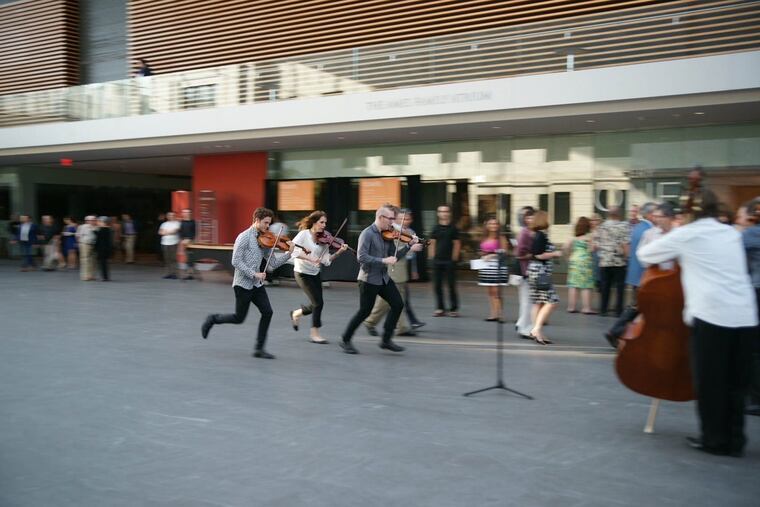‘Ten Thousand Birds’ concert at Morris Arboretum will immerse listeners in sounds of nature
The composition by John Luther Adams encourages musicians and listeners move around.

Outdoor concerts in unconventional places have been a default move over the pandemic, though prize-laden composer John Luther Adams has embraced concerts without walls for years. With full awareness of nature’s advantages and unpredictability, works such as Ten Thousand Birds — presented by Penn Live Arts on Sept. 25 at Morris Arboretum — are becoming his trademark.
The Pulitzer- and Grammy-winning composer, a longtime Alaska resident now based in rural New Mexico, has an immersive spirit: Ten Thousand Birds, which dates from 2014, refers to the number of species on the planet, not the plethora of birdsong crowded into the hour-long piece.
Even quoting 21 types of birds and frogs, conceptually, “is impossibly grandiose — as my ideas often are,” says the 68-year-old composer. Adams has to slow down the bird songs — from owls to towhees — in order to be intelligible by the human ear, a technique popularized by French composer Olivier Messiaen. Then there are the thrushes with two windpipes.
“These are very complex vocalizations and sonorities that hover on the edge of melody and timbre,” Adams said by phone from his New Mexico home. “Somewhere along the way I realized … I’m translating a language I don’t understand and will never understand. Things get lost. Maybe everything gets lost. But something else is gained … and I receive music that might not have come to me any other way.”
Unlike Messiaen, whose lifelong interest in ornithology was fused with intense religiosity, Adams identifies his primary responsibility as that of a composer. “If it doesn’t work as music, then anything else I might imagine about it is meaningless. So the music has to come first,” he said.
The ultimate goal is creating “a sense of hearing something you didn’t anticipate from a location that you can’t identify.”
That aesthetic translates into a dreamy stream of sounds with frequent interruptive elements that coexist, seemingly without much effort, but actually arise from a flexible, intricate game plan. Though Adams’ formal concert works have strong musical architecture, Ten Thousand Birds reflects and embraces the random quality of the arboretum setting. Each page of music is its own module that can arranged in whatever order the instrumentalists sees fit, in what Adams calls “a performance kit” rather than a score.
Both musicians and listeners are encouraged to move around within prescribed boundaries. No wonder the project gives Penn Live Arts an augmented identity that executive and artistic director Christopher Gruits says goes “beyond the walls of the Annenberg Center.”
But before any of Adams’ notes are played , the performance starts with purposeful silence so that the audience hears the environment before Alarm Will Sound alters it. The ensemble’s cofounder Alan Pierson has arranged the order of the pages to convey a sense of morning, noon, and night.
“It’s intentional that everyone gets a different experience,” said Pierson, “but I try to structure it so that … you will hear all the elements that make up the piece.”
Last week’s performance at New York City’s Governors Island had the advantage of former military residences that could reflect the instrumentalists’ unamplified sound back at the audience. For the Morris performances, Pierson has been studying satellite photos to determine optimum placement of the players..
One wild card, of course, is how wildlife might interact with the piece. “There’s a sense of different things happening around you, some of which are in dialogue with each other or not happening in dialogue,” he said.
Climatology messages aren’t explicit. In fact, the piece is so flexible that Pierson adapted it into a video, all shot indoors, titled Ten Thousand Screens, that captured the loneliness of the early lockdown months.
Adams approved the idea grudgingly. He lived in Alaska in the 1970s to work in environmental protection, so outdoor matters are much on the composer’s mind, and is even more evident with his forthcoming commission for The Crossing Choir and Philadelphia Orchestra. Its title, Vespers for the Anthropocene, refers to a geological era where the planet is directly changed by human presence.
“What keeps me getting up every morning and going over to my studio … is my faith in the next generation that’s going to have to sort through the rubble that my generation is leaving to them and create a new way of living on this earth,” he said. “Hope is not a word I use any longer. It’s kicked around too easily. The music I’m writing now is an expression of grief and faith in the possibility of human redemption.”
Alarm Will Sound performs Ten Thousand Birds at 1 and 4 p.m. Saturday, Sept. 25 (rain date Sunday, Sept. 26) at the Bloomfield Farm at Morris Arboretum, 100 E. Northwestern Ave. Tickets: $15-35. The Penn Live Arts production is in conjunction with On the Environment Film Series Sept. 16-26. Information: https://pennlivearts.org.